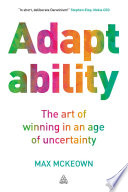

In a world characterized by rapid change and uncertainty, adaptability has emerged as a crucial skill for individuals and organizations alike. The book emphasizes that adaptability is not merely a reactive measure but a proactive strategy that can lead to innovation and growth. It discusses how the ability to pivot in response to new information, shifting market conditions, or unexpected challenges can differentiate successful entities from those that fail. The author illustrates this point with numerous case studies of companies that thrived because they embraced change and adapted their strategies accordingly. This idea underscores the necessity of fostering a culture of adaptability within organizations, where employees feel empowered to experiment, learn from failures, and continuously evolve.
Continue readingA significant theme in the book is the role of mindset in adaptability. The author draws on psychological research to explain how a growth mindset—believing that abilities can be developed through dedication and hard work—enhances an individual's capacity to adapt. This section delves into the cognitive aspects of adaptability, highlighting how mental flexibility allows individuals to consider multiple perspectives and solutions when faced with challenges. The book provides practical strategies for cultivating a growth mindset, such as embracing challenges, persisting through difficulties, and learning from criticism. It argues that fostering this mental approach is essential for personal and professional growth in an ever-changing environment.
Continue readingAdaptability is increasingly intertwined with technology. The book discusses how advancements in technology can facilitate adaptability by providing tools and resources that enable quicker responses to change. It examines various technological trends, such as artificial intelligence, big data, and automation, and how they can be leveraged to enhance decision-making and operational efficiency. The author also warns of the potential pitfalls of over-reliance on technology, emphasizing the need for a balanced approach that combines human creativity and intuition with technological capabilities. This section serves as a guide for organizations looking to integrate technology into their adaptability strategies effectively.
Continue readingResilience is a key component of adaptability. The book outlines the relationship between resilience and the ability to adapt to change, arguing that resilient individuals and organizations are better equipped to handle setbacks and uncertainties. It discusses the importance of developing coping strategies, emotional intelligence, and a supportive network to enhance resilience. The author shares stories of individuals and organizations that have demonstrated remarkable resilience in the face of adversity, providing readers with relatable examples of how resilience can be cultivated. This idea is particularly relevant for leaders seeking to foster a resilient culture within their teams.
Continue readingThe book highlights the significance of collaboration in enhancing adaptability. It argues that in a complex and interconnected world, individuals and organizations must work together to navigate change effectively. The author discusses the concept of social adaptability, which involves the ability to adjust one's behavior and communication styles to work harmoniously with diverse teams. This section provides insights into building effective collaboration practices, such as open communication, trust-building, and conflict resolution. By emphasizing the importance of teamwork, the book illustrates how collaborative efforts can lead to innovative solutions and greater adaptability.
Continue readingContinuous learning is presented as a vital aspect of adaptability. The book encourages readers to adopt a lifelong learning mindset, emphasizing that staying relevant in today's fast-paced world requires ongoing education and skill development. The author provides practical tips for integrating learning into daily routines, such as seeking feedback, engaging in professional development opportunities, and leveraging online resources. This idea resonates particularly with professionals aiming to advance their careers and remain competitive in their fields. The book also discusses the role of organizations in fostering a culture of continuous learning, highlighting the benefits of investing in employee development.
Continue readingFinally, the book addresses the necessity of embracing uncertainty and risk as inherent aspects of adaptability. The author argues that fear of the unknown often hinders individuals and organizations from taking necessary risks that could lead to growth and innovation. This section explores strategies for reframing uncertainty as an opportunity rather than a threat, encouraging readers to adopt a proactive approach to risk management. The book shares examples of successful entrepreneurs and leaders who took calculated risks and thrived, reinforcing the idea that adaptability requires a willingness to step outside of one's comfort zone and embrace the unknown.
Continue reading